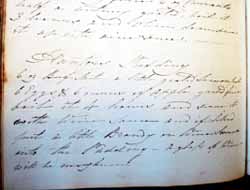Articles from the Thoroton Society Newsletter
Caroline Waeick’s Recipe Book

Recipe for ‘Spinster’s Pudding’ in Caroline Waeick’s recipe book. The picture is reproduced by permission of UNMASC.
Amongst the regular items emailed last year from the University of Nottingham Department of Manuscripts and Special Collections (UNMASC) was a request to help with identifying some recent acquisitions. One which caught our eye was a recipe book with the dedication ‘Caroline Waeick from your affectionate mother May 20th 1839’. The University Department had no more information than this, so an inspection of the recipe book was indicated. The book is a manuscript book with some 180 pages of good-quality paper and bound in a fine leather cover.1 It would probably have been very expensive when first purchased. The writing is in an elegant script and the pages are numbered. There is no indication of ownership or authorship other than the dedication on the first page. The book contains a wide range of recipes, which allude to a middle-class lifestyle and definitely not that of a poor family. The recipes appear to cover all that a married woman would need to feed her family and entertain her friends. We estimate that there are upwards of two hundred recipes in the book. Amongst the recipes are Mushroom Catsup; Lobster Sauce; Oxford Pudding; Spinster’s Pudding; Bakewell Pudding; Mince Meat; Lemon Sillabubs(sic); Cowslip Wine.
As an example of the recipes, for ‘Spinster’s Pudding’ (page 83 in the recipe book) take “6 ounces of beef suet, with a little grated lemon peel; 6 eggs; 6 ounces of apple grated fine. Boil it four hours and serve with wine sauce and if liked just a little brandy or wine with the pudding. A glass of wine will be enough”.
There are several loose sheets of paper with the book. These contain recipes for household cleaning materials, cosmetics such as cold cream and one medicine - Seidlitz powder, a commonly-used aperient (laxative) which was popular well into the 20th century.
Caroline Elizabeth Waeick was born on 25 April 1809 in Marylebone and baptised on 14 May 1809 at St Mary’s Church, St Marylebone Road, London. Her parents were John Philip Waeick (c.1786-1854) who was born in Germany and Jane Minnick (1786-1851). John and Jane had a large family:
John Philip (1807-1889) who married Mary McCarthy. They had several children.
Caroline Elizabeth (1809-1841)
Sophia (1810-1837)
George (1812-1881)
Frederick L. (1814-1846)
Charles (1818-1848)
Frances Jane (1819-1906) who married Stephen Barrett (1812-1880). There were several children.
There are living descendants of John Philip-Mary McCarthy, and of Frances Jane-Stephen Barrett.
Caroline died in 1841 at the age of 31. She had not married. It is possible that the recipe book was a gift to her from her mother in view of an impending marriage which never took place, possibly owing to an illness resulting in Caroline’s early death.
John Philip Waeick (Caroline’s father) was a baker who had premises in Bethnal Green, London. He was involved as a witness in the passing of ‘bad’ (i.e. forged) money2. On 13th December 1851, a William Hurrell had entered Mr Waeick’s bakery and purchased two penny rolls, which he paid for with a half-crown. Mr Waeick realised that the coin was ‘bad’ and informed the police. A policeman came to sit in the back room of the bakery, and shortly afterwards Hurrell came in to purchase a quartern loaf (a large loaf weighing around four pounds), again tendering a ‘bad’ half-crown. The policeman promptly arrested Hurrell who was found guilty at the Old Bailey of unlawfully uttering counterfeit coin. He was sentenced to twelve months’ imprisonment.
1. UNMASC reference MS355/1
2. Old Bailey Proceedings, 5th January 1852. Reference Number: t18520105-164
John and Janet Wilson
< Previous